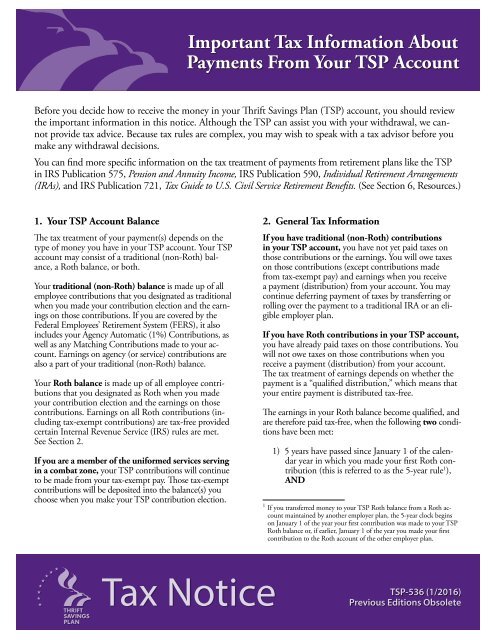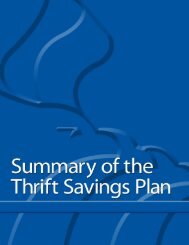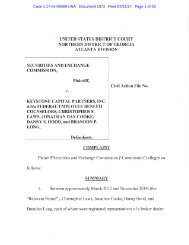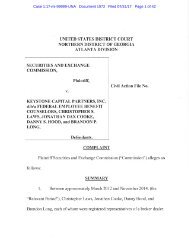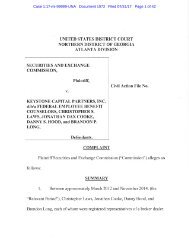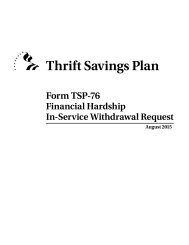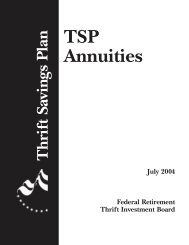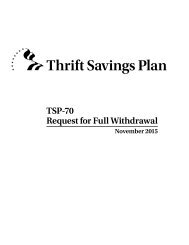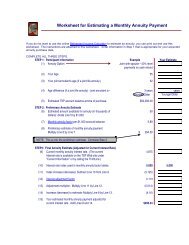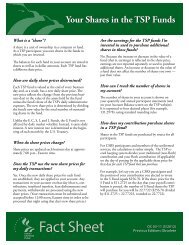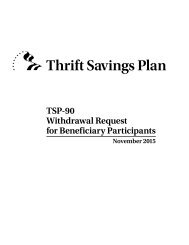Important Tax Information About Payments From Your TSP Account
Create successful ePaper yourself
Turn your PDF publications into a flip-book with our unique Google optimized e-Paper software.
<strong>Important</strong> <strong>Tax</strong> <strong>Information</strong> <strong>About</strong><br />
<strong>Payments</strong> <strong>From</strong> <strong>Your</strong> <strong>TSP</strong> <strong>Account</strong><br />
Before you decide how to receive the money in your Thrift Savings Plan (<strong>TSP</strong>) account, you should review<br />
the important information in this notice. Although the <strong>TSP</strong> can assist you with your withdrawal, we cannot<br />
provide tax advice. Because tax rules are complex, you may wish to speak with a tax advisor before you<br />
make any withdrawal decisions.<br />
You can find more specific information on the tax treatment of payments from retirement plans like the <strong>TSP</strong><br />
in IRS Publication 575, Pension and Annuity Income, IRS Publication 590, Individual Retirement Arrangements<br />
(IRAs), and IRS Publication 721, <strong>Tax</strong> Guide to U.S. Civil Service Retirement Benefits. (See Section 6, Resources.)<br />
1. <strong>Your</strong> <strong>TSP</strong> <strong>Account</strong> Balance<br />
The tax treatment of your payment(s) depends on the<br />
type of money you have in your <strong>TSP</strong> account. <strong>Your</strong> <strong>TSP</strong><br />
account may consist of a traditional (non-Roth) balance,<br />
a Roth balance, or both.<br />
<strong>Your</strong> traditional (non-Roth) balance is made up of all<br />
employee contributions that you designated as traditional<br />
when you made your contribution election and the earnings<br />
on those contributions. If you are covered by the<br />
Federal Employees’ Retirement System (FERS), it also<br />
includes your Agency Automatic (1%) Contributions, as<br />
well as any Matching Contributions made to your account.<br />
Earnings on agency (or service) contributions are<br />
also a part of your traditional (non-Roth) balance.<br />
<strong>Your</strong> Roth balance is made up of all employee contributions<br />
that you designated as Roth when you made<br />
your contribution election and the earnings on those<br />
contributions. Earnings on all Roth contributions (including<br />
tax-exempt contributions) are tax-free provided<br />
certain Internal Revenue Service (IRS) rules are met.<br />
See Section 2.<br />
If you are a member of the uniformed services serving<br />
in a combat zone, your <strong>TSP</strong> contributions will continue<br />
to be made from your tax-exempt pay. Those tax-exempt<br />
contributions will be deposited into the balance(s) you<br />
choose when you make your <strong>TSP</strong> contribution election.<br />
2. General <strong>Tax</strong> <strong>Information</strong><br />
If you have traditional (non-Roth) contributions<br />
in your <strong>TSP</strong> account, you have not yet paid taxes on<br />
those contributions or the earnings. You will owe taxes<br />
on those contributions (except contributions made<br />
from tax-exempt pay) and earnings when you receive<br />
a payment (distribution) from your account. You may<br />
continue deferring payment of taxes by transferring or<br />
rolling over the payment to a traditional IRA or an eligible<br />
employer plan.<br />
If you have Roth contributions in your <strong>TSP</strong> account,<br />
you have already paid taxes on those contributions. You<br />
will not owe taxes on those contributions when you<br />
receive a payment (distribution) from your account.<br />
The tax treatment of earnings depends on whether the<br />
payment is a “qualified distribution,” which means that<br />
your entire payment is distributed tax-free.<br />
The earnings in your Roth balance become qualified, and<br />
are therefore paid tax-free, when the following two conditions<br />
have been met:<br />
1) 5 years have passed since January 1 of the calendar<br />
year in which you made your first Roth contribution<br />
(this is referred to as the 5-year rule 1 ),<br />
AND<br />
1 If you transferred money to your <strong>TSP</strong> Roth balance from a Roth account<br />
maintained by another employer plan, the 5-year clock begins<br />
on January 1 of the year your first contribution was made to your <strong>TSP</strong><br />
Roth balance or, if earlier, January 1 of the year you made your first<br />
contribution to the Roth account of the other employer plan.<br />
<strong>Tax</strong> Notice<br />
<strong>TSP</strong>-536<br />
(1/2016)<br />
Previous Editions Obsolete
2<br />
2) You have reached age 59½ or have a permanent<br />
disability 2 or in the case of your death. (Note: If<br />
you are a beneficiary participant 3 , the Roth earnings<br />
in your account become qualified when 5<br />
years have passed since January 1 of the calendar<br />
year in which the deceased <strong>TSP</strong> participant first<br />
made a Roth contribution to the account.)<br />
If the payment from your Roth balance is not a qualified<br />
distribution and you do not transfer or roll over the<br />
payment to a Roth IRA or Roth account maintained by<br />
an eligible employer plan, you will be taxed on the earnings<br />
in the payment. If you are under age 59½, a 10%<br />
early withdrawal penalty tax on early distributions may<br />
also apply to the earnings (unless an exception applies,<br />
see Section 5). However, if you transfer or roll over the<br />
payment, you will not have to pay taxes currently on the<br />
earnings and you will not have to pay taxes on payments<br />
that later become qualified distributions.<br />
In summary, if the payment from your <strong>TSP</strong> Roth balance<br />
is a qualified distribution, you will not be taxed on<br />
any part of the payment even if you do not transfer or<br />
roll over the payment. If the payment from your <strong>TSP</strong><br />
account is a nonqualified distribution and you transfer<br />
or roll over the payment, you will not be taxed on the<br />
amount you transfer or roll over. Any earnings on the<br />
amount you transfer or roll over will not be taxed if paid<br />
later in a qualified distribution.<br />
If you have both a traditional (non-Roth) and a Roth<br />
balance in your <strong>TSP</strong> account, any withdrawals you<br />
make will be paid proportionally from each balance.<br />
Example:<br />
<strong>TSP</strong> account balance = $10,000; participant<br />
chooses to make a full withdrawal.<br />
Traditional portion of balance at time of withdrawal<br />
= $5,000 (50% of total <strong>TSP</strong> account)<br />
Roth portion of balance at time of withdrawal<br />
= $5,000 (50% of total <strong>TSP</strong> account)<br />
Withdrawal election:<br />
Single Payment = 20%<br />
Life Annuity = 0%<br />
<strong>TSP</strong> Monthly <strong>Payments</strong> = 80%<br />
Result:<br />
Single payment = $2,000, comprised of $1,000<br />
(50%) traditional money and $1,000 (50%)<br />
Roth money.<br />
Monthly payments = $8,000. Each monthly<br />
payment will be comprised of 50% traditional<br />
money and 50% Roth money.<br />
Note: Be aware that if you receive a payment from an<br />
account that has both taxable and tax-exempt contributions,<br />
your distribution will be paid proportionally from<br />
taxable and nontaxable amounts. Additionally, any payment<br />
from your Roth balance will be paid proportionally<br />
from your Roth contributions and earnings.<br />
We report all <strong>TSP</strong> distributions to the IRS, and to you,<br />
on IRS Form 1099-R, Distributions <strong>From</strong> Pensions,<br />
Annuities, Retirement or Profit-Sharing Plans, IRAs,<br />
Insurance Contracts, etc. Distributions from beneficiary<br />
participant accounts will be reported as death payments<br />
on IRS Form 1099-R.<br />
3. Federal Income <strong>Tax</strong> Withholding<br />
We must withhold for Federal income tax from the taxable<br />
portion of certain payments described in Section 2 unless<br />
you are allowed to request reduced or no withholding for<br />
certain payment types. For purposes of IRS withholding,<br />
there are three types of payments: eligible rollover<br />
distributions, periodic payments, and non-periodic<br />
payments. The chart on the next page describes the withholding<br />
rates and the rules that apply to each type of <strong>TSP</strong><br />
payment. If you are eligible and want to change the standard<br />
withholding, you may do so by completing the tax<br />
withholding section on your withdrawal request form.<br />
If you elect a post-separation “mixed withdrawal” (e.g.,<br />
an annuity and a single payment), each type of distribution<br />
is treated separately and may be subject to different<br />
tax withholding rules.<br />
We do not withhold for state or local income tax. However,<br />
we do report, on IRS Form 1099-R, all <strong>TSP</strong> distributions<br />
to your state of residence at the time of the<br />
payment (if that state has an income tax). You may need<br />
to pay state and local income taxes on your payment.<br />
See a tax advisor or state or local tax officials for specific<br />
information.<br />
2 The <strong>TSP</strong> cannot certify to the IRS that you meet the Internal Revenue<br />
Code’s definition of a disability when your taxes are reported. Therefore,<br />
you must provide the justification to the IRS when you file your taxes.<br />
3 A beneficiary participant is a spouse beneficiary of a deceased civilian or<br />
uniformed services <strong>TSP</strong> participant who has an account established in his<br />
or her name.
<strong>Tax</strong> Treatment for <strong>TSP</strong> <strong>Payments</strong> 1<br />
May I Waive Withholding?<br />
May I Decrease<br />
Withholding?<br />
May I Increase Withholding?<br />
What Is the Withholding<br />
Rate?<br />
May I Transfer or Roll<br />
Over the Payment?<br />
Type of Payment<br />
for IRS Purposes<br />
Type of <strong>TSP</strong> Payment<br />
Yes — complete tax withholding section<br />
of Form <strong>TSP</strong>-25.<br />
No 10% Yes — complete tax withholding section<br />
of Form <strong>TSP</strong>-25.<br />
Automatic enrollment refund 2 Non-periodic<br />
payment<br />
No<br />
Yes — complete the withholding section<br />
of your withdrawal request form. 3 No<br />
Eligible rollover<br />
distribution<br />
Yes 20%<br />
Single payment full withdrawal after<br />
separation or from a beneficiary<br />
participant account<br />
Monthly payments for less than 10 Eligible rollover<br />
years (requested amount) 4 distribution<br />
Monthly payments for 10 years or Periodic payments<br />
more (requested amount) 5<br />
Yes — complete the<br />
Yes — complete the withholding section withholding section Yes — complete the withholding section<br />
of your withdrawal request form. of your withdrawal request form. 3 of your withdrawal<br />
request form. 3 3<br />
As if married with 3<br />
dependents<br />
No<br />
Periodic payments<br />
Monthly payments based on the<br />
IRS life expectancy table<br />
Rollover only None Not applicable Not applicable Not applicable<br />
Eligible rollover<br />
distribution<br />
Automatic cash-out (less than $200)<br />
Yes 20%<br />
Yes — complete the withholding section<br />
No<br />
No 10% Yes — complete line 3 of IRS Form<br />
Yes of your withdrawal request form. 3<br />
W4-P. 3 No<br />
— complete line 1 of IRS Form<br />
W4-P. 3<br />
Eligible rollover<br />
distribution<br />
Partial withdrawal after separation<br />
or from a beneficiary participant<br />
account<br />
Required minimum distribution Non-periodic<br />
payments 6 payments<br />
Eligible rollover<br />
distribution<br />
Final single payment after a series<br />
of monthly payments<br />
Yes 20%<br />
3<br />
No<br />
Yes — complete the withholding section<br />
of your withdrawal request form. 3<br />
Eligible rollover<br />
distribution<br />
Age-based in-service withdrawal<br />
No 10% Yes — complete the withholding section<br />
of your withdrawal request form. 3<br />
Non-periodic<br />
payment<br />
Financial hardship in-service<br />
withdrawal<br />
Rollover only (using<br />
personal funds) Not applicable —<br />
No<br />
money already paid<br />
Eligible rollover<br />
distribution<br />
Loan taxable distribution —<br />
default by separation<br />
Not applicable Not applicable Not applicable<br />
Non-periodic<br />
payment<br />
Loan taxable distribution —<br />
default while still employed<br />
Yes No<br />
20% Yes — complete the withholding section of<br />
No<br />
No<br />
No 10%<br />
your payment method election form. 3 Yes — complete the withholding section<br />
Yes — complete the withholding section<br />
of your withdrawal request form. 3 of your withdrawal request form. 3<br />
Court order payment to a current Eligible rollover<br />
or former spouse 7 distribution<br />
Non-periodic<br />
payment<br />
Court order payment (not to current<br />
or former spouse); IRS tax levy;<br />
Restitution order (MVRA)<br />
Non-periodic<br />
payment<br />
Death benefit from a beneficiary<br />
participant account<br />
20% Yes — complete line 3 of IRS Form<br />
W4-P. 3 No<br />
Only to an “inherited”<br />
IRA<br />
Eligible rollover<br />
Death benefit to a non-spouse 8 distribution<br />
Annuity purchase <strong>Payments</strong> will be reported for tax purposes by the annuity provider. The annuity provider will send information to participants about making a withholding election.<br />
1 Withholding only applies to the taxable portion of the payment (e.g., the earnings portion of a nonqualified Roth distribution.)<br />
2 Withholding rules that apply to refunds of automatic enrollment contributions paid out as withdrawals using Form <strong>TSP</strong>-70 are based on the withdrawal option chosen on that form.<br />
3<br />
Some versions of withdrawal request forms have tax withholding sections that should be completed in lieu of IRS Form W-4P, Withholding Certificate for Pensions or Annuity <strong>Payments</strong>.<br />
4 If the payment is satisfying the IRS required minimum distribution amount, it is treated as a non-periodic payment. See the “Required minimum distribution payments” section of this chart.<br />
5<br />
<strong>Payments</strong> are treated as periodic even if they are satisfying the IRS required minimum distribution amount.<br />
6<br />
Required minimum distributions are not treated as non-periodic payments (for IRS purposes) if they are part of monthly payments that are expected to be paid over 10 or more years or are part of monthly payments that are based<br />
on the IRS life expectancy table. In these cases, taxes are based on withholding for a married person with 3 dependents, under the IRS withholding rules for periodic payments.<br />
7 Court order payments made to a current or former spouse of a beneficiary participant are treated as non-periodic payments.<br />
8 Death benefits paid to a non-spouse are treated as non-periodic payments if they come from a beneficiary participant account.
4<br />
Automatic enrollment refunds: If you separated from<br />
service within the first 90 days of having become automatically<br />
enrolled in the <strong>TSP</strong>, and your balance is $200 or<br />
more, you can request a refund of your automatic enrollment<br />
contributions or a withdrawal from your account.<br />
If your account has less than $200 when you separate, the<br />
balance will be sent to your address of record automatically<br />
and no federal tax withholding will be taken. (Note:<br />
Automatic enrollment refunds do not apply to beneficiary<br />
participant accounts.)<br />
CSRS Participants. Use Form <strong>TSP</strong>-25, Automatic<br />
Enrollment Refund Request, to request your refund.<br />
You will receive your own contributions (plus earnings<br />
or minus losses), there will be 10% withholding for<br />
Federal income tax, and you will not pay an early withdrawal<br />
tax penalty.<br />
FERS Participants. You can use Form <strong>TSP</strong>-25, Automatic<br />
Enrollment Refund Request, to request your<br />
refund. Any Agency Matching Contributions (plus<br />
earnings or minus losses) and nonvested Agency Automatic<br />
(1%) Contributions (plus earnings or minus<br />
losses) will be forfeited to the <strong>TSP</strong>. You will receive your<br />
own contributions (plus earnings or minus losses),<br />
there will be 10% withholding for Federal income tax,<br />
and you will not pay an early withdrawal tax penalty.<br />
Alternatively, you can use Form <strong>TSP</strong>-70, Request for<br />
Full Withdrawal, to obtain your refund. You will receive<br />
your own contributions (plus earnings or minus losses)<br />
and all Agency Matching Contributions (plus earnings<br />
or minus losses). There will be 20% tax withholding,<br />
and you may be subject to the 10% IRS early withdrawal<br />
tax penalty. Also, you will forfeit your Agency<br />
Automatic (1%) Contributions, unless you were “vested”<br />
(entitled to keep them).<br />
Annuities: <strong>Payments</strong> you receive from an annuity that<br />
the <strong>TSP</strong> purchases for you are also subject to tax withholding<br />
depending upon whether they contain traditional<br />
(non-Roth) contributions and/or nonqualified Roth<br />
earnings. The annuity provider will send information<br />
about making a withholding election.<br />
4. Transferring or Rolling Over <strong>Your</strong> <strong>TSP</strong><br />
Distribution<br />
Some payments from the <strong>TSP</strong> may be transferred or rolled<br />
over into an IRA or eligible employer plan. Such payments,<br />
called “eligible rollover distributions,” are identified on<br />
the chart on the previous page. Be aware that the tax rules<br />
regarding transfers and rollovers can be complicated. You<br />
should consult a tax advisor to ensure that you understand<br />
the tax consequences of such a transaction.<br />
An eligible employer plan includes a plan qualified under<br />
section 401(a) of the Internal Revenue Code, such as<br />
a section 401(k) plan, profit-sharing plan, defined benefit<br />
plan, stock bonus plan, and money purchase plan; a section<br />
403(a) annuity plan; a section 403(b) tax-sheltered<br />
annuity; and a section 457(b) plan maintained by a governmental<br />
employer. Certain eligible employer plans also<br />
accept money designated as Roth.<br />
A traditional IRA is any IRA that is not a Roth IRA, a<br />
SIMPLE IRA, or an education IRA. <strong>Tax</strong>-deferred money<br />
that is transferred from the <strong>TSP</strong> to a traditional IRA is<br />
not subject to tax until it is withdrawn from the IRA.<br />
A Roth IRA accepts only after-tax dollars, but provides<br />
tax-free growth. If you transfer your <strong>TSP</strong> traditional<br />
(non-Roth) balance to a Roth IRA, you must pay taxes<br />
on the funds for the year of the transfer.<br />
Be aware that no IRA or eligible employer plan is required<br />
to accept a transfer or rollover. Before you decide<br />
to transfer or roll over your <strong>TSP</strong> account, you should find<br />
out whether your IRA or plan accepts transfers or rollovers,<br />
the minimum amount it will accept, and whether<br />
tax-exempt contributions or Roth contributions, if applicable,<br />
will be accepted.<br />
If your payment is an eligible rollover distribution, you<br />
may ask the <strong>TSP</strong> to transfer part or all of the payment<br />
directly to your IRA or eligible employer plan. If you<br />
receive an eligible rollover distribution in the form of a<br />
check paid to you, you may deposit (roll over) the payment<br />
into your IRA or eligible employer plan in certain<br />
situations. The type of plan to which you can transfer or<br />
roll over your payment depends on whether the money<br />
you transfer or roll over is from your traditional (non-<br />
Roth) balance or your Roth balance.<br />
<strong>Your</strong> Transfer and Rollover Options for <strong>Payments</strong><br />
<strong>From</strong> a Traditional (non-Roth) Balance<br />
You may transfer or roll over your traditional (non-Roth)<br />
balance to a traditional IRA, an eligible employer plan, or<br />
a Roth IRA.<br />
Keep in mind that the plan you choose to transfer or roll<br />
your funds into may be subject to different tax treatment<br />
and plan rules (such as different spousal consent rules)<br />
than the <strong>TSP</strong>.<br />
If you choose to have the <strong>TSP</strong> transfer part or all of<br />
your eligible rollover distribution, the <strong>TSP</strong> will make<br />
the payment directly to your traditional IRA, Roth IRA,<br />
or eligible employer plan. Also, the following rules apply:
5<br />
• The transfer of your traditional (non-Roth) balance<br />
to a traditional IRA or eligible employer plan will<br />
not be taxed in the current year and no income tax<br />
will be withheld. <strong>Your</strong> payment will be taxed when<br />
you withdraw it from the traditional IRA or the<br />
eligible employer plan.<br />
• The entire transfer of your traditional (non-Roth)<br />
balance to a Roth IRA will be taxed in the current<br />
year. No income tax will be withheld at the time of<br />
the transfer. However, you may need to pay estimated<br />
taxes to mitigate your tax liability.<br />
• If you are 70½ or older and a portion of your payment<br />
is a required minimum distribution, that<br />
portion cannot be transferred. Instead, it will be<br />
paid directly to you after 10% has been deducted<br />
for Federal income tax withholding. This rule also<br />
applies if you are receiving monthly payments and<br />
elect to receive a final single payment that includes a<br />
required minimum distribution.<br />
If the <strong>TSP</strong> pays an eligible rollover distribution directly<br />
to you, and you decide to do a rollover to a traditional<br />
IRA, Roth IRA, or eligible employer plan yourself:<br />
• You will have up to 60 days after you receive the<br />
payment to make the deposit into your IRA or<br />
plan to avoid tax on the amount you roll over.<br />
• The <strong>TSP</strong> is required to withhold 20% of your payment<br />
for Federal income taxes. This means that in<br />
order to roll over your entire payment, you must<br />
use other funds to make up for the 20% withheld.<br />
• If you do not roll over the entire amount of your<br />
payment, the portion not rolled over will be taxed<br />
and will also be subject to the 10% early withdrawal<br />
penalty if you are under age 59½ (unless an<br />
exception applies).<br />
If you roll over your payment into a Roth IRA, the full<br />
amount rolled over will be taxed in the current year.<br />
Special note regarding tax-exempt money: <strong>TSP</strong> taxexempt<br />
balances in both uniformed services accounts and<br />
the beneficiary participant accounts that result from them<br />
may be transferred or rolled over into a traditional IRA<br />
or a Roth IRA or transferred to certain eligible employer<br />
plans, but only if the IRA or plan certifies that it accepts<br />
tax-exempt balances. Otherwise, the tax-exempt amount<br />
will be paid directly to you. Check with your IRA trustee<br />
or plan administrator to see if the funds will be accepted.<br />
The <strong>TSP</strong> will transfer the taxable portion of the withdrawal<br />
first. <strong>Tax</strong>-exempt money will be transferred only if<br />
the taxable portion of the withdrawal does not satisfy the<br />
transfer request.<br />
<strong>Your</strong> Transfer and Rollover Options for <strong>Payments</strong><br />
<strong>From</strong> a Roth Balance<br />
You may transfer or roll over your Roth balance to a Roth<br />
IRA or a Roth account maintained by an eligible employer<br />
plan that will accept the rollover. Keep in mind that the<br />
rules of the Roth IRA or eligible employer plan that receives<br />
the rollover will determine your investment options,<br />
fees, and rights to payment from the Roth IRA or eligible<br />
employer plan. For example, no spousal consent rules apply<br />
to Roth IRAs, and Roth IRAs may not provide loans.<br />
Further, the amount rolled over will become subject to the<br />
tax rules that apply to the Roth IRA or the Roth account<br />
maintained by the eligible employer plan. In general, these<br />
tax rules are similar to those described elsewhere in this<br />
notice, but differences include the following:<br />
• If you do a transfer or rollover to a Roth IRA, your<br />
Roth IRA (or all of your Roth IRAs, if you have<br />
more than one) will determine whether you have<br />
satisfied the 5-year rule (counting from January 1<br />
of the year for which your first contribution was<br />
made to any of your Roth IRAs).<br />
• If you do a transfer or rollover to a Roth IRA, you<br />
will not be required to take a distribution from<br />
the Roth IRA during your lifetime, and you must<br />
keep track of the total amount of the after-tax<br />
contributions in all of your Roth IRAs (in order to<br />
determine your taxable income for later Roth IRA<br />
payments that are not qualified distributions).<br />
• Eligible rollover distributions from a Roth IRA can<br />
only be rolled over to another Roth IRA. Note:<br />
Distributions from Roth IRAs are paid first from<br />
contributions, then from earnings.<br />
If you choose to have the <strong>TSP</strong> transfer part or all of<br />
your eligible rollover distribution, the <strong>TSP</strong> will make<br />
the payment directly to your Roth IRA or Roth account<br />
maintained by an eligible employer plan.<br />
• The transfer of your Roth balance to a Roth IRA<br />
or a Roth account maintained by an eligible employer<br />
plan will not be taxed in the current year<br />
and no income tax will be withheld. However, your<br />
payment from that plan may be taxed when you<br />
withdraw it. If, at that time, your payment does<br />
not meet the IRS rules for qualified earnings (see<br />
Section 2), the taxable portion will be subject to<br />
Federal tax withholding. (Note: If your Roth earnings<br />
are not qualified and you are under age 59½,<br />
an early withdrawal penalty may also apply.)
6<br />
• If a portion of your payment is a required minimum<br />
distribution, that portion cannot be transferred. Instead,<br />
it will be paid directly to you after 10% Federal<br />
tax withholding has been deducted from the taxable<br />
portion of your required minimum distribution. This<br />
rule also applies if you are receiving monthly payments<br />
and elect to receive a final single payment that<br />
includes a required minimum distribution.<br />
• If you choose to have the <strong>TSP</strong> transfer only a portion<br />
of your payment and a portion is paid to you,<br />
the taxable portion will be transferred first. Nontaxable<br />
money will be transferred only if the taxable<br />
portion of the withdrawal does not satisfy the<br />
participant’s transfer election.<br />
If the <strong>TSP</strong> pays an eligible rollover distribution directly<br />
to you, and you decide to do a rollover to a Roth<br />
IRA or Roth account maintained by an eligible employer<br />
plan yourself:<br />
• You will have up to 60 days after you receive the<br />
payment to make the deposit into your Roth IRA<br />
or Roth account maintained by an eligible employer<br />
plan.<br />
• If your payment is not a qualified Roth distribution,<br />
the <strong>TSP</strong> is required to withhold 20% of the<br />
earnings for Federal income taxes. This means that<br />
in order to roll over your entire payment to a Roth<br />
IRA, you must use other funds to make up for the<br />
20% withheld.<br />
• You can only roll over your distribution into a<br />
Roth account maintained by an eligible employer<br />
plan if the payment is nonqualified (taxable) and<br />
the rollover amount does not exceed the amount of<br />
the earnings in the payment.<br />
• You cannot do a 60-day rollover to an eligible employer<br />
plan of any part of a qualified distribution.<br />
• If you receive a nonqualified distribution and you do<br />
not roll over an amount at least equal to the amount<br />
of the earnings, you will be taxed on the amount of<br />
the earnings not rolled over. You will also be subject<br />
to the 10% early withdrawal penalty tax on the<br />
amount of nonqualified earnings not rolled over if<br />
you are under age 59½ (unless an exception applies).<br />
Beneficiary participants: You have the same transfer and<br />
rollover options that the participant would have had as<br />
described in this section.<br />
5. Other <strong>Tax</strong> Rules<br />
Repayment of Plan Loans<br />
The <strong>TSP</strong> must declare a taxable distribution on the<br />
entire unpaid balance (including any accrued interest) of<br />
your loan if:<br />
• You fail to repay your loan in accordance with your<br />
Loan Agreement.<br />
• You miss a loan payment and you do not submit<br />
the amount needed to bring your payments up-todate<br />
within the specified time period.<br />
• You do not repay your loan in full when you separate<br />
from Federal service.<br />
This means that the IRS will consider the unpaid balance<br />
of your loan to be taxable income. In addition, if<br />
you are under age 59½, you may have to pay a 10% early<br />
withdrawal penalty tax on the taxable portion of the loan.<br />
Once a taxable distribution has been declared, the loan is<br />
closed and you will not be allowed to repay it.<br />
If any part of your loan is associated with tax-exempt<br />
or Roth contributions, those contributions will not be<br />
subject to tax. However, the following conditions apply<br />
to Roth earnings:<br />
• If the taxable distribution is declared because you<br />
separate from Federal service, only Roth earnings<br />
that are not qualified will be subject to tax.<br />
• If the taxable distribution is declared for another<br />
reason (such as a default on your loan), the Roth<br />
earnings included in the distribution will be subject<br />
to tax, even if you have already met the conditions<br />
necessary for your Roth earnings to be qualified.<br />
Consult the IRS or a tax advisor for information and advice if<br />
your loan is declared a taxable distribution.<br />
If the taxable loan distribution was declared because<br />
you separated from Federal service, you may be able<br />
to roll it over (within 60 days of the distribution date) to<br />
an IRA or an eligible employer plan using your personal<br />
funds. (See the rollover rules in Section 4.) If you are able<br />
to do a rollover, you will avoid current tax and, if applicable,<br />
an additional 10% penalty tax on any taxable portion<br />
that you roll over. Members of the uniformed services can<br />
also roll over tax-exempt amounts if the IRA or eligible<br />
employer plan will accept tax-exempt money.
7<br />
The <strong>TSP</strong> will send you the appropriate tax form by<br />
January 31 of the year after the distribution.<br />
Additional 10% Penalty <strong>Tax</strong><br />
If you receive a <strong>TSP</strong> distribution before you reach age<br />
59½, in addition to the regular income tax, you may have<br />
to pay an early withdrawal penalty tax equal to 10% of<br />
any taxable portion of the distribution not transferred or<br />
rolled over. The additional 10% tax generally does not<br />
apply to payments that are<br />
• paid after you separate from service during or<br />
after the year you reach age 55 (or the year you<br />
reach age 50 if you are a public safety employee as<br />
defined in section 72(t)(10)(B)(ii) of the Internal<br />
Revenue Code);<br />
• annuity payments;<br />
• automatic enrollment refunds;<br />
• made as a result of total and permanent disability; 4<br />
• made because of death;<br />
• made from a beneficiary participant account;<br />
• made in a year you have deductible medical expenses<br />
that exceed 10% of your adjusted gross<br />
income (7.5% if you or your spouse is 65 or over); 4<br />
• ordered by a domestic relations court; or<br />
• paid as substantially equal payments over your life<br />
expectancy.<br />
Members of the uniformed services: The penalty tax<br />
does not apply to any portion of a <strong>TSP</strong> distribution<br />
(including a loan) which represents tax-exempt contributions<br />
from pay earned in a combat zone.<br />
Relief from the 10% early withdrawal penalty is available<br />
to eligible Reservists called to duty for more than 179<br />
days. The Reservist must have been activated after September<br />
11, 2001, and must have received his or her <strong>TSP</strong><br />
distribution between the date of the order or call and the<br />
close of the active duty period. The Reservist may also be<br />
eligible to repay the distribution to an IRA (not the <strong>TSP</strong>).<br />
Participants should consult with their tax advisors, legal<br />
assistance officers, or the IRS regarding this relief.<br />
4 The <strong>TSP</strong> cannot certify to the IRS that you meet this exemption requirement<br />
when your taxes are reported. Therefore, you must provide the<br />
justification to the IRS when you file your taxes.<br />
Receiving Monthly <strong>Payments</strong><br />
Participants receiving monthly payments may change the<br />
amount annually. If you elect to change the fixed dollar<br />
amount of your payments, if you transfer money into<br />
your account while receiving monthly payments, or if<br />
you change from payments based on life expectancy to<br />
a fixed dollar amount, the withholding from the taxable<br />
portion of your payment may change. The withholding<br />
rules will be determined according to whether your new<br />
payments are eligible rollover distributions or periodic<br />
payments (based on your account balance at the time the<br />
payment changes), and whether the payment is taxable,<br />
tax-free, or a combination of the two.<br />
In addition, changing from monthly payments based<br />
on life expectancy to a fixed monthly payment amount<br />
may make you liable for the 10% penalty tax on the<br />
payments you previously received, if you do so within 5<br />
years of beginning your payments or before you are age<br />
59½. To learn more, see IRS Publication 575, Pension<br />
and Annuity Income.<br />
Required Minimum Distribution if You Are Over 70½<br />
If you are over age 70½ and are separated from Federal<br />
service, you must either withdraw your entire <strong>TSP</strong> account<br />
or begin receiving monthly payments by April 1<br />
of the year following the year you turned 70½. In addition,<br />
this April 1 date is the deadline for the <strong>TSP</strong> to start<br />
to distribute the IRS “required minimum distribution,”<br />
a minimum amount of the money in your account that<br />
you must receive each year. For more information, see the<br />
<strong>TSP</strong> tax notice “<strong>Important</strong> <strong>Tax</strong> <strong>Information</strong> <strong>About</strong> <strong>Your</strong><br />
<strong>TSP</strong> Withdrawal and Required Minimum Distributions.”<br />
Beneficiary participants: Special rules apply to required<br />
minimum distributions from beneficiary participant accounts.<br />
To learn more, see the <strong>TSP</strong> tax notice “<strong>Tax</strong> <strong>Information</strong><br />
<strong>About</strong> <strong>TSP</strong> Withdrawals and Required Minimum<br />
Distributions for Beneficiary Participants.”<br />
Special <strong>Tax</strong> Treatment if You Were Born Before<br />
January 2, 1936<br />
If you were born before January 2, 1936, and you receive<br />
your entire account in a lump sum distribution, you can<br />
make a one-time election to calculate the amount of the<br />
tax on the distribution by using the 10-year tax option and<br />
using 1986 tax rates. The 10-year tax option often reduces<br />
the taxes that you owe. To learn more, see IRS Publication<br />
575, Pension and Annuity Income. The 10-year tax option<br />
does not apply to beneficiary participant accounts.
8<br />
Rules for Nonresident Aliens or Beneficiaries of<br />
Nonresident Aliens<br />
If you are a nonresident alien and you do not have the<br />
<strong>TSP</strong> transfer your payment to a U.S. IRA or a U.S. employer<br />
plan, the <strong>TSP</strong> is generally required to withhold<br />
30% (instead of 20%) of the payment for Federal income<br />
taxes. If the amount withheld exceeds the amount of tax<br />
you owe (as may happen if you roll over an amount that<br />
the <strong>TSP</strong> pays directly to you), you may request an income<br />
tax refund by filing IRS Form 1040-NR, U.S. Nonresident<br />
Alien Income <strong>Tax</strong> Return and attaching your IRS<br />
Form 1042-S, Foreign Person's U.S. Source Income Subject<br />
to Withholding. See IRS <strong>From</strong> W-8BEN, Certificate<br />
of Foreign Status of Beneficial Owner for United States<br />
<strong>Tax</strong> Withholding, for claiming that you are entitled to a<br />
reduced rate of withholding under an income tax treaty.<br />
For more information, see also <strong>TSP</strong> tax notice “Special<br />
<strong>Tax</strong> Withholding Rules for Thrift Savings Plan <strong>Payments</strong><br />
to Nonresident Aliens,” IRS Publication 519, U.S. <strong>Tax</strong><br />
Guide for Aliens, and IRS Publication 515, Withholding of<br />
<strong>Tax</strong> on Nonresident.<br />
Death Benefit <strong>Payments</strong> and Court-Ordered <strong>Payments</strong><br />
For information on the tax treatment of death benefit<br />
payments to an individual who is not the surviving<br />
spouse of a <strong>TSP</strong> participant, read the <strong>TSP</strong> tax notice<br />
“<strong>Important</strong> <strong>Tax</strong> <strong>Information</strong> <strong>About</strong> Thrift Savings Plan<br />
Death Benefit <strong>Payments</strong>.”<br />
For information on the tax treatment of court-ordered payments,<br />
read the <strong>TSP</strong> tax notice “<strong>Tax</strong> Treatment of Thrift<br />
Savings Plan <strong>Payments</strong> Made Under Qualifying Orders.”<br />
6. Resources<br />
<strong>TSP</strong> publications are available from the <strong>TSP</strong> website at<br />
tsp.gov or from the <strong>TSP</strong> by calling the <strong>TSP</strong> toll free at<br />
1-877-968-3778 (TDD: 1-877-847-4385). Outside the<br />
U.S. and Canada, please call 404-233-4400 (not toll<br />
free). You can also send a fax to 1-866-817-5023 or write<br />
to the <strong>TSP</strong> at the address on the <strong>TSP</strong> website. IRS publications<br />
are from your local IRS office, on the IRS website<br />
at www.irs.gov, or by calling 1-800-TAX-FORM.


